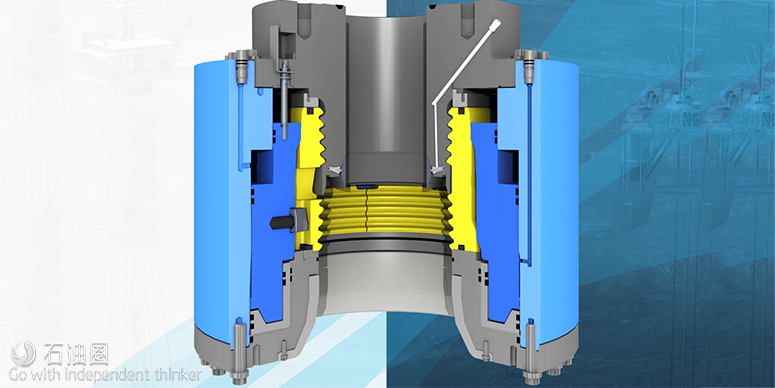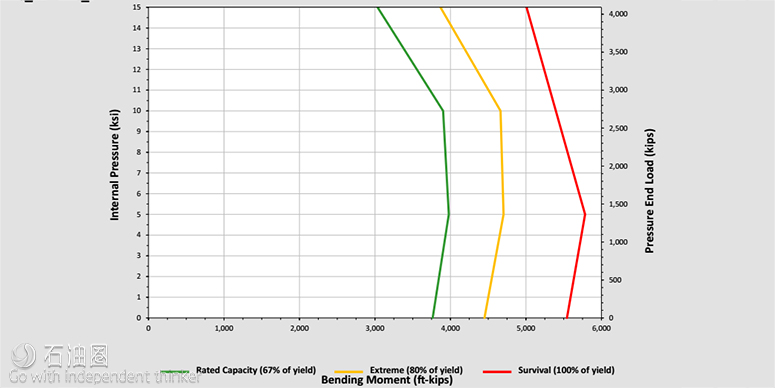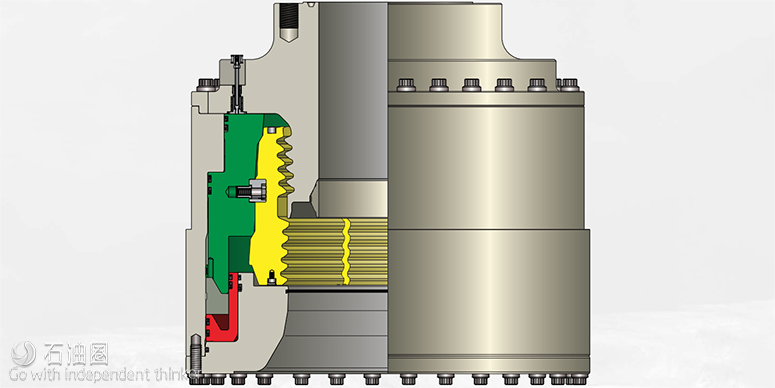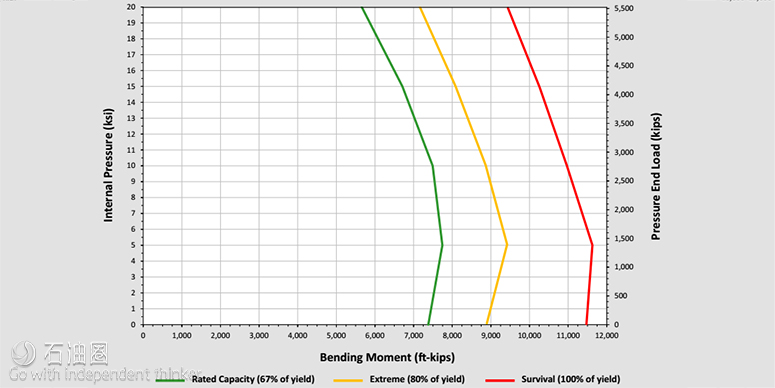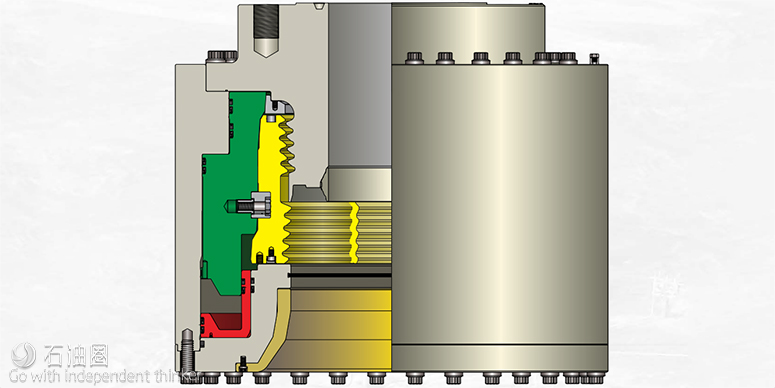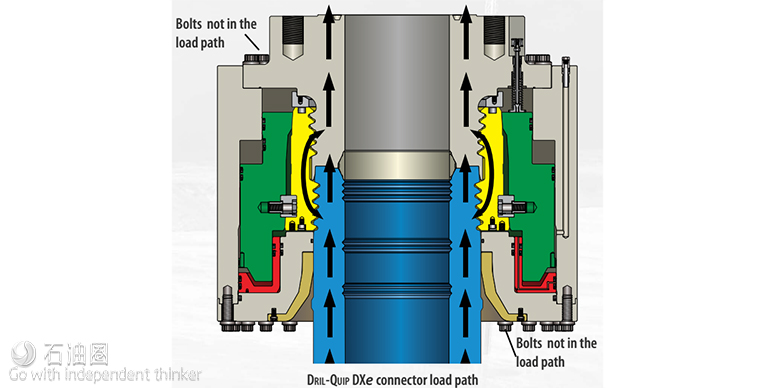Dril-Quip DXe™ Wellhead Connector
Dril-Quip’s new DXe™ Wellhead Connector is designed for use as a BOP stack connector, subsea tree connector or riser tie-back connector and is suitable for use in HP/HT service and severe bending and high fatigue applications.
A highly engineered latching segment to wellhead locking profile provides increased load capacity. The new DXe ring gasket has both primary and secondary sealing areas, is self-aligning and provides the connector to wellhead interface with increased bending capacity. When the connector is locked onto a wellhead, loads are transmitted through the upper body, through latch segments and into the wellhead locking profile. None of the DXe connector’s bolts are in the load path, eliminating the possibility of connector failure due to bolt failures that the industry has recently experienced. The technology of this critical connection between the wellhead connector and subsea wellhead has been validated to the latest editions of API 16A (4th Edition) PR2 classification, and API 17TR7 requirements. Through rigorous full-scale structural and fatigue testing, the technology in the DXe connector has demonstrated that it delivers reliable performance, higher bending capacity and superior fatigue life.
Dril-Quip’s DXe Subsea Connectors offer the following unique features:
• Unique proprietary highly engineered locking profile provides high fatigue, high load capacity
• No bolts in load path – load path is through the connector upper body, latch segments and wellhead
• Available with flange, studded or integral connection
• Superior performance validated with full scale testing
•Exceeds API 16A PR2 and API 17TR7 requirements
• No gasket leaks during worst case survival load testing of the DXe-30 at 20,000 psi bore pressure
• Increased hub contact area provides high bending capacity
• Bolts are a controlled hardness grade L7 and conforms to API 20E
• Gaskets qualified to API 6A PR2 20,000 psi (with gas), 35°to 400° F
• Self-aligning primary and secondary ring gasket designs
• Design is compatible with existing blowout preventer hydraulic control systems
• Can be configured for H-4 locking profile
• Available on all Dril-Quip subsea trees
• Available for riser tie-back applications
• Maximizes the drilling vessel watch circle
DXe-27 Connector
Ideally suited for standard and deepwater drilling applications, Dril-Quip’s DXe-27 Wellhead Connector is designed for 27″ O.D.wellhead and is available in a 15,000 psi WP rating.
DXe-27 Specifications
Rated Working Pressure(kpsi):15
Swallow (inches):23.32
Added Stack Height(inches):22.13
Outside Diameter:(inches):54.38
Weight(lbs):19,400
Fluid Volume to Latch (gal):7.39
Fluid Volume to Unlatch (gal):11.26
Fluid Volume for Secondary Unlatch (gal):13.66
DXe-30 Connector
Ideally suited for standard and high bending deepwater applications, Dril-Quip’s DXe-30 Wellhead Connector is designed for a 30″ O.D. wellhead and is available in a 20,000 psi WP rating. A DXDW adapter kit is available to configure a DXe-30 to mate with a 15,000 psi 27″ O.D. wellhead.
DXe-30 Specifications
Rated Working Pressure:15 or 20
Swallow(inches):27.49
Added Stack Height(inches):27.50
Outside Diameter(inches):64.53
Weight(lbs):38,500
Fluid Volume to Latch (gal):14.53
Fluid Volume to Unlatch (gal):20.50
Fluid Volume for Secondary Unlatch(gal):25.64
DXe Primary and Secondary Metal-to-Metal Sealing
Dril-Quip DXe series Connectors feature a special profile that mates with a proprietary DXe ring gasket. This DXe sealing profile features a pair of independent metal-to-metal sealing surfaces. There is a two-step sealing surface; one for a primary DXe ring gasket and second sealing surface for an independent secondary DXe ring gasket.
The primary DXe gasket used during normal operations protects the secondary metal-to-metal sealing surface from damage. Should the primary sealing surface become damaged, a secondary DXe ring gasket can be installed. The secondary ring gasket utilizes the secondary sealing surface for a reliable metal-to-metal seal.
Internal Pressure Rating – 20,000 psi
External Pressure Rating – 5,000 psi
Water Depth Rating – over 11,000 ft
DXe Series Connector Ring Gaskets are Self-Aligning
The DXe Connector and both primary and secondary ring gaskets have been designed to facilitate a self aligning feature, while protecting the primary and secondary sealing surfaces. This is accomplished with a unique metal sealing surface that features upper and lower alignment guidance. The ring gasket Retainer Mechanism is spring loaded for automatic ring gasket retention. The retention mechanism releases the ring gasket with hydraulic pressure.
The DXe ring gasket has alignment guides that engage the ring gasket surface geometry in the upper body of the connector. As the connector moves down against a misaligned ring gasket, these alignment guides assist alignment while protecting the metal sealing surfaces.
Continued downward movement of the connector and the alignment guides automatically adjusts the ring gasket into the proper position. Both alignment guides assure the seal-ing surfaces are not touched as this movement occurs.
As the connector lands out, the ring gasket settles into the sealing position and is preloaded when the connector is locked and the latch segments are energized. Retention pins automatically engage the ring gasket for retrieval when the connector is lifted off the wellhead.
The DXe Connector and Assembly Bolt Standards
Some wellhead connectors used in the subsea drilling industry have a load path that drives applied preload through a series of bolts required for assembly. These bolts are exposed to sea water and experience cyclic loads from the drilling riser and tension loads generated by internal pressure. Fatigue cycles coupled with material imperfec-tions, material strength, and toughness variations can come together to form cracks that can propagate through the threads on the bolt, causing it to break. This issue becomes more pronounced when bolts are exposed to sea water which accelerates the corrosion process.
In recent years, bolts that are integral to subsea equipment have failed due to corrosion cracking and related material hardness issues. In 2013, the U.S. Department of the Inte-rior (DOI) started an investigation after numerous bolts on connectors in service were found to be broken. Additional industry groups have formed to investigate metallurgical data to determine if alloys used in the heavy steel bolts are ductile enough to survive harsh underwater environments, and if the coatings that are used on these bolts are appropri-ate. The API organization has released API 20E to mandate bolt traceability and establish standards for quality levels.
The DXe Connector design addresses this problem. It features radial latch segments that are driven into mating load profiles with an annular piston/cam ring. This action provides the necessary gasket preload required between wellhead hub face and the upper body of the connector. When the connector is locked and in operation, the load path travels through the connector, the wellhead main body and the latch segments via the locking profile. As the segment latches to the wellhead, it clamps to the connector upper body simultaneously and creates a closed loop with a near straight load path. Any loads applied to the connector travel only through the segments that are made from ductile alloy steel and do not pass through bolts. Bolts in the DXe Connector do not see high stresses of these operating loads and are not subjected to the failed bolt problems associated with existing connectors.

 石油圈
石油圈